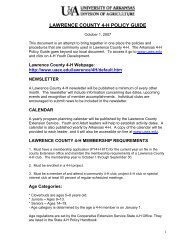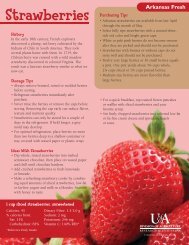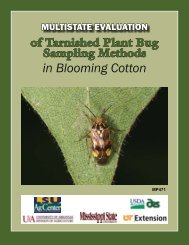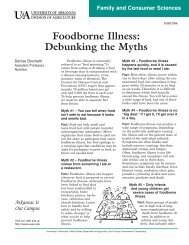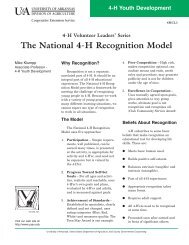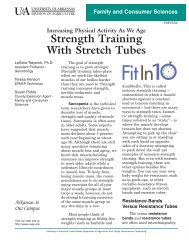Mosquito Life Cycle - AG1163 - University of Arkansas Cooperative ...
Mosquito Life Cycle - AG1163 - University of Arkansas Cooperative ...
Mosquito Life Cycle - AG1163 - University of Arkansas Cooperative ...
You also want an ePaper? Increase the reach of your titles
YUMPU automatically turns print PDFs into web optimized ePapers that Google loves.
tend to only live a week or two while<br />
female mosquitoes can live for up to a<br />
month and produce multiple batches <strong>of</strong><br />
eggs. Some mosquito species overwinter<br />
as blood-fed females and can survive for<br />
multiple months.<br />
Funding<br />
Provided by the U.S. Environmental<br />
Protection Agency, Region VI Office,<br />
Dallas, Texas.<br />
Authors<br />
Dr. Don L. Renchie (Extension Program<br />
Leader for Agricultural and Environmental<br />
Safety, Coordinator-Pesticide<br />
Safety Education Project (PSEP), Assistant<br />
Pr<strong>of</strong>essor and Extension Specialist);<br />
Dr. Mark Johnsen (Extension Assistant,<br />
Agricultural and Environmental Safety);<br />
and Ples Spradley (Associate Pr<strong>of</strong>essor-<br />
Pesticide Education, Department <strong>of</strong><br />
Plant Pathology-Extension, <strong>University</strong> <strong>of</strong><br />
<strong>Arkansas</strong> Division <strong>of</strong> Agriculture)<br />
Date <strong>of</strong> Publication<br />
June, 2007<br />
<strong>AG1163</strong><br />
<strong>Cooperative</strong> Extension Service, <strong>University</strong> <strong>of</strong> <strong>Arkansas</strong>,<br />
United States Department <strong>of</strong> Agriculture, and County<br />
Governments Cooperating.<br />
The <strong>Arkansas</strong> <strong>Cooperative</strong> Extension Service <strong>of</strong>fers<br />
its programs to all eligible persons regardless <strong>of</strong> race,<br />
color, national origin, religion, gender, age, disability,<br />
marital or veteran status, or any other legally protected<br />
status, and is an Affirmative Action/Equal Opportunity<br />
Employer.<br />
Printed by <strong>University</strong> <strong>of</strong> <strong>Arkansas</strong> <strong>Cooperative</strong><br />
Extension Service Printing Services.<br />
<strong>Mosquito</strong> <strong>Life</strong> <strong>Cycle</strong><br />
<strong>Mosquito</strong>es are most <strong>of</strong>ten thought <strong>of</strong> as<br />
blood-thirsty pests that spread disease<br />
and ruin our outdoor activities. However,<br />
the majority<br />
<strong>of</strong> the<br />
mosquito’s<br />
life cycle<br />
is spent in<br />
the water,<br />
and it is<br />
only the<br />
adult stage<br />
that adversely affects human and animal<br />
health. This knowledge <strong>of</strong>fers us points<br />
in their life cycle to initiate control before<br />
they can reach the adult stage. Each stage<br />
in the mosquito life cycle has diverse<br />
morphology (how they look), but they all<br />
follow a general life cycle which has been<br />
described in detail in this handout.
The Stages <strong>of</strong> the <strong>Life</strong> <strong>Cycle</strong><br />
<strong>of</strong> <strong>Mosquito</strong>es<br />
All mosquitoes<br />
go through four<br />
distinct stages<br />
(egg-larvaepupa-adult)<br />
in<br />
their life cycle<br />
which can<br />
vary in length<br />
depending<br />
on temperature<br />
and food<br />
resources. In<br />
the summertime<br />
it takes mosquitoes 3-10 days to<br />
totally complete their life cycle from egg<br />
to adult.<br />
EGG STAGE<br />
<strong>Mosquito</strong><br />
species are<br />
broken into<br />
two categories<br />
based on where<br />
in the environment<br />
they lay their eggs. Floodwater<br />
mosquito species lay their eggs above<br />
the water level in areas that are prone to<br />
periodic flooding. These oviposition (egg<br />
laying) sites range from cattle ho<strong>of</strong> prints<br />
to empty soda cans. The eggs from these<br />
mosquito species can persist in the environment<br />
for 3 months to 2 years and is the<br />
stage used to survive the winter. Standing<br />
water mosquito species lay their eggs<br />
on the surface <strong>of</strong> transient and permanent<br />
pools <strong>of</strong> water. Some species lay their<br />
eggs singly while others glue 100-200<br />
eggs together forming miniature rafts.<br />
Within 24-48 hours these eggs will hatch<br />
in the environment.<br />
LARVAL STAGE<br />
Once hatched,<br />
mosquito larvae (or<br />
wigglers) go through<br />
four instars (time<br />
period between<br />
molts), increasing in<br />
size after each molt.<br />
The larval stage<br />
displays a great variation in morphology<br />
between the mosquito species and is used<br />
for identification purposes. Most mosquito<br />
species feed by filtering microorganisms<br />
(bacteria, protozoa, fungi) out <strong>of</strong> the<br />
water, but<br />
there are<br />
several<br />
predaceous<br />
species that<br />
feed on other<br />
mosquito<br />
larvae.<br />
Larvae must breathe atmospheric oxygen<br />
and will lay horizontal (only Anopheles<br />
spp.) or 45 degrees to the water surface.<br />
Some species have the capability <strong>of</strong> puncturing<br />
underwater plant cells to receive<br />
oxygen and never have to surface.<br />
PUPAL STAGE<br />
The fourth instar<br />
larvae molts<br />
into the commashaped<br />
stage<br />
called the pupa<br />
(or tumblers). This is the transition stage<br />
between the aquatic stages <strong>of</strong> the mosquito’s<br />
life cycle and the terrestrial adult<br />
stage. <strong>Mosquito</strong> pupae do not feed but<br />
are mobile and use a tumbling motion to<br />
escape predation. Within 24-48 hours the<br />
pupa will molt into an adult.<br />
ADULT<br />
STAGE<br />
After the<br />
adult mosquito<br />
emerges, it<br />
seeks a protective<br />
environment<br />
in the surrounding vegetation to<br />
allow its wings to complete development.<br />
Male mosquitoes tend to emerge prior<br />
to the female mosquito and will mate<br />
with the female as soon as she is capable.<br />
Female and male mosquitoes both require<br />
carbohydrate sources (nectar, plant exudates)<br />
throughout their life to maintain<br />
energy for flying, mating, and seeking<br />
hosts for blood meals. Only the female<br />
mosquito takes a blood meal because she<br />
needs the extra protein to develop eggs.<br />
The process <strong>of</strong> taking a blood meal is how<br />
the mosquito is able to vector viruses,<br />
protozoans, and helminthes (worms) to<br />
humans and animals. Male mosquitoes





